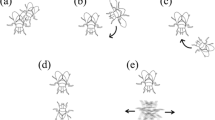Abstract
The courtship behavior of Drosophila sechelliais described. Male wing displays are mainly vibration and scissoring, with low levels of rowing. As courtship proceeds the proportion of courtship spent in male wing vibration and licking increases, whereas female movement decreases. The male courtship song of sechelliacontains pulse song but no sine song. This species also shows a distinctive “copulation song” associated with mounting and copulation. The main cuticular hydrocarbon in females is 7,11-heptacosadiene. The number of copulations increased when flies were placed in the presence of food. Visual and acoustic stimuli appear to be important for mating. A multidimensional comparison was used to compare members of the melanogaster species subgroup, based upon courtship behavior, song characteristics, and cuticular hydrocarbons. A multidimensional comparison of courtship sequences in sechellia, melanogaster, simulans,and mauritianashowed differences in variability between the two island species as compared to the two cosmopolitan species. The courtship song of D. orenais described: it shows both sine and pulse song; there is also a “copulation song” in this species.
Similar content being viewed by others
References
Antony, C., and Jallon, J. -M. (1982). The chemical basis for sex recognition inDrosophila melanogaster.J. Insect Physiol. 30: 873–880.
Ashburner, M., Bodmer, M., and Lemeunier, F. (1984). On the evolutionary relationships ofDrosophila melanogaster.Dev. Genet. 4: 295–312.
Bastock, M., and Manning, A. (1955). The courtship ofDrosophila melanogaster.Behaviour 8: 85–111.
Cobb, M., Burnet, B., and Connolly, K. (1986). The structure of courtship in theDrosophila melanogaster species sub-group.Behaviour 97: 182–212.
Cobb, M., Connolly, K., and Burnet, B. (1985). Courtship behaviour in themelanogaster species sub-group ofDrosophila.Behaviour 95: 203–231.
Cobb, M., Connolly, K., and Burnet, B. (1987). The relationship between locomotor activity and courtship behaviour in themelanogaster species sub-group ofDrosophila.Anim. Behav. 35: 705–713.
Connolly, K., and Cook, R. (1973). Rejection responses by femaleDrosophila melanogaster: Their ontogeny, causality and effects upon the behaviour of the courting male.Behaviour 44: 142–166.
Cowling, D. E., and Burnet, B. (1981). Courtship songs and genetic control of their acoustic characters in sibling species of theDrosophila melanogaster sub-group.Anim. Behav. 29: 924–935.
Coyne, J. A., and Kreitman, M. (1986). Evolutionary genetics of two sibling species,Drosophila simulons andD. sechellia.Evolution 40: 673–691.
Dunn, G., and Everitt, B. S. (1982).An Introduction to Mathematical Taxonomy, Cambridge University Press, London.
Ewing, E. (1983). Functional aspects ofDrosophila courtship.Biol. Rev. 58: 275–292.
Gailey, D. A., Lacaillade, R. C., and Hall, J. C. (1986). Chemosensory elements of courtship in normal and mutant, olfaction-deficientDrosophila melanogaster.Behav. Genet. 16: 375–405.
Healy, M. J. R. (1972). Drawing a probability ellipse.J. Roy. Stat. Soc. Ser. C 21: 202–204.
Ikeda, H., Takabatake, I., and Nobuaki, S. (1980). Variation in courtship sounds among three geographical strains ofDrosophila mercatorum.Behav. Genet. 10: 361–375.
Jallon, J.-M. (1984). A few chemical words exchanged byDrosophila during courtship and mating.Behav. Genet. 14: 441–478.
Jallon, J.-M., and David, J. R. (1987). Variations in cuticular hydrocarbons among the eight species of theDrosophila melanogaster sub-group.Evolution 41: 294–302.
Jallon, J.-M., Antony, C., Chan Yong, T. P., and Maniar, S. (1986). Genetic factors controlling the production of aphrodisiac substances inDrosophila. In Porchet, M., Andries, J.-C. and Dhainaut, A. (eds.),Advances in Invertebrate Reproduction 4, Elsevier, Amsterdam.
Kyriacou, C. P., and Burnet, B. (1979). Genetic analysis of phototaxis near the upper limit of the visual spectrum inDrosophila melanogaster.Behav. Genet. 9: 123–128.
Lachaise, D., David, J. R., Lemeunier, F., Tsacas, L., and Ashburner, M. (1986). The reproductive relationships ofDrosophila sechellia withD. mauritiana, D. simulans andD. melanogaster from the Afrotropical region.Evolution 40: 262–271.
Louis, D., and David, J. R. (1986). Ecological specialization in theDrosophila melanogaster species sub-group: A case study ofD. sechellia.Acta Oecol. 7: 215–229.
Luyten, I. (1982). Variations intraspécifique et interspécifique des hydrocarbures cuticulaires chezDrosophila simulons et espèces affines.C.R. Acad. Sci. Paris 295: 733–736.
Markow, T., and Hanson, S. (1981). Multivariate analysis ofDrosophila courtship.Proc. Natl. Acad. Sci. (USA) 78: 430–434.
Manning, A. (1967). Antennae and sexual receptivity in Drosophila melanogaster females.Science 158: 136–137.
Pechiné, J. M., Antony, C., and Jallon, J.-M. (1988). Precise characterization of cuticular compounds in youngDrosophila melanogaster by mass spectrometry.J. Chem. Ecol. 14: 1071–1085.
Solignac, M., and Monnerot, M. (1986). Race formation, speciation and introgression withinDrosophila simulans, D. mauritiana andD. sechellia inferred from mitochondrial DNA analysis.Evolution 40: 531–539.
Tompkins, L., Gross, A. C., Hall, J. C., Gailey, D. A., and Siegel, R. W. (1982). The role of female movement in the sexual behavior ofDrosophila melanogaster.Behav. Genet. 12: 295–307.
Tsacas, L., and Bachli, G. (1981).Drosophila sechellia, n.sp., Huitième espèce du sous-groupemelanogaster des Iles Sechelles (Diptera, Drosophilidae).Rev. Fr. Entomol. (N.S.) 3: 146–150.
Venard, R., and Jallon, J.-M. (1980). Evidence for an aphrodisiac pheromone of femaleDrosophila.Experietia 36: 211–213.
von Schilcher, F. (1976). The role of auditory stimuli in the courtship ofDrosophila melanogaster.Anim. Behav. 24: 18–26.
Author information
Authors and Affiliations
Rights and permissions
About this article
Cite this article
Cobb, M., Burnet, B., Blizard, R. et al. Courtship inDrosophila sechellia: Its structure, functional aspects, and relationship to those of other members of theDrosophila melanogaster species subgroup. J Insect Behav 2, 63–89 (1989). https://doi.org/10.1007/BF01053619
Accepted:
Issue Date:
DOI: https://doi.org/10.1007/BF01053619




